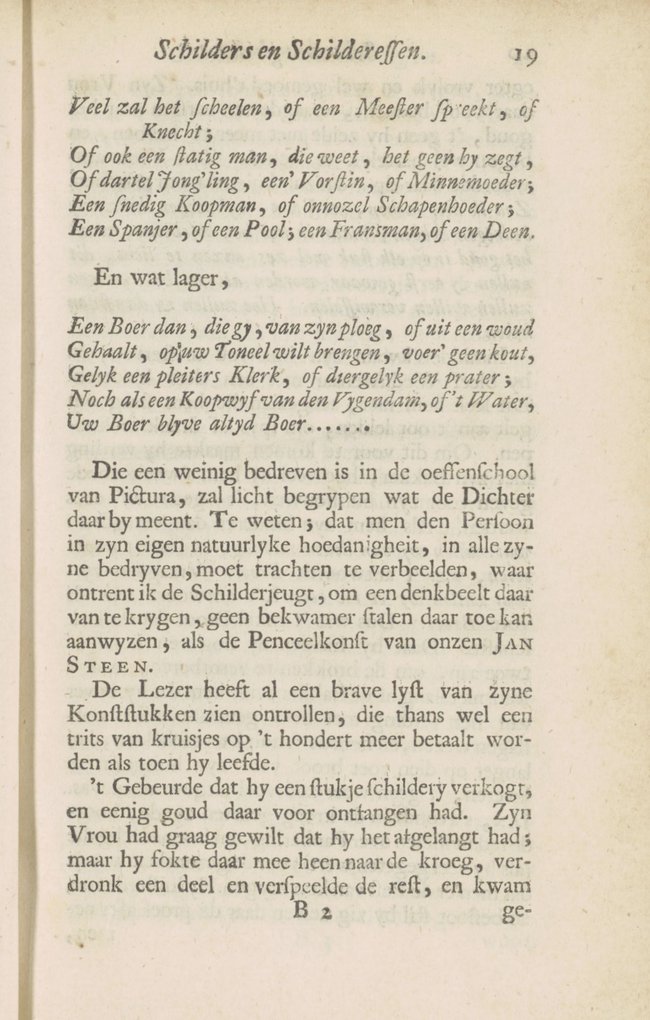Volume 3, page 10-19
Page 10
had received it? She told the complete circumstances of the matter, from which this gift originated, so that the case became known and talked about.
The woman, when she heard say that it was worth 100 ducats, believed that the old gentleman made mock of her and asked whether he would give her that much money for it? Who answered yes, and more, but he charged her to take it to the most important art-loving gentlemen, which he pointed out to her, saying ask 900 guilders for it, as she did, and it was at once sold.
The woman, who came home to her husband with such a rich booty for that small panel, given to her as a reward for that mentioned service, was welcome.
Certainly this payment for that service deserves praise, and while the most cautious cannot foresee such an accident in the dark, which can happened to the most pious man, there is no way to avoid it other than by what you will hear at the end of the following story.
On a Sunday evening, being dark, a certain dignified gentleman heads down the street and tumbles into a tub of plaster, by which a new cloak that he had on had its colour eaten away and was totally ruined. What does he do? The next day he complains to a burgomaster with whom he was on good footing about his disaster, with the request that such tubs, placed in front of the houses being bricked, might be moved from the street to some other locations before nightfall; and if the burgomaster did not want to put this in order, he would be necessitated to do it himself, so that it might not happen again.
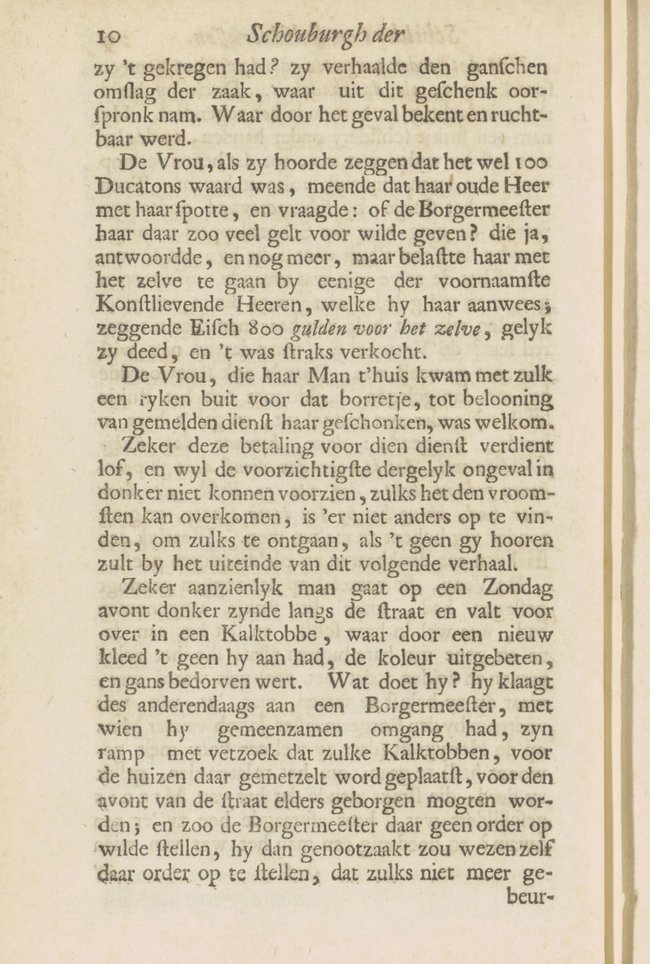
Page 11
The burgomaster, surprised at such unseemly open-hearted speaking, said: How are you going to take care of this? I have come to the decision (answered he) always to head from the street into my house before dark.
But skipping over all this to speed to the end, we only wish to say something of his late art work, which had remained incomplete, seeing that death begrudged him time to complete it. In it is depicted Mary, who sits reading, a small statue of Christ who measures his cross, and Joseph in the distance at his workbench, which has remained incomplete. The figure of the woman is dressed in celadon coloured linen so artfully and broadly pleated that one can see nothing more beautiful [1].
He would have had 1,500 guilders from the Marquis de Bethune [= François Gaston de Béthune, marquis de Chabris]. But since the widow of our Mieris did not want to part with it for less (although incomplete), the Marquis turned it down and it later passed into the hands of Mister Isaac Desoubrie in Leiden, in whose art cabinet it still hangs.
He died on the 12th of March 1681, barely 46 years old.
Caspar Brandt composed his grave inscription thus;
Halt pedestrian, this is Mieris’ grave,
The phoenix of his fellow artists:
Who gave speech, and life to pictures,
Lies lifeless locked up here:
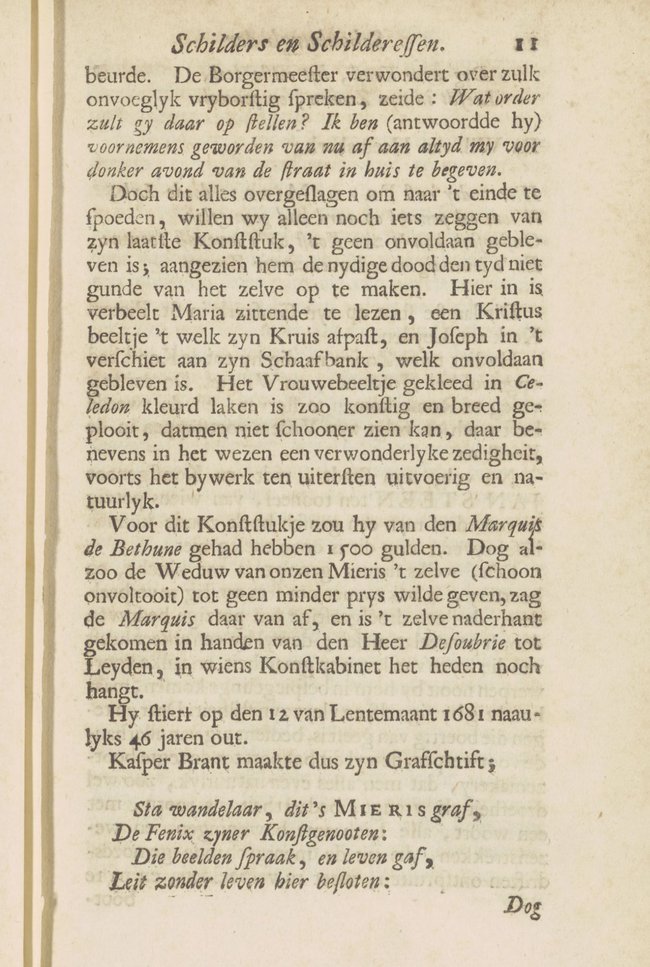

1
Frans van Mieris (I) Willem van Mieris
The Holy Family at home in Bethlehem, c. 1681
Private collection
Page 12
But his art, the noblest part,
Lives in his sons, and brush.
And Willem Jacobz. van Heemskerk:
Here below this rests Frans Mieris’ dead corpse,
Whose noble brush had no equal on earth.
His immortal art can show him most alive:
And the lively emulation of his sons.
The latter inscription stands on his grave stone in Saint Peter’s church in Leiden.
He left two sons after he had raised them to art, Jan and Willem. The first died early in Rome and the second still lives and follows in his father’s footsteps in art.
Now follows his fellow townsman, contemporary and artist JAN STEEN on stage, about whose farcical biography one could write a whole book. But that is not our intention.
One whose nature is inclined to farce and jesting is better able to depict something serious than a melancholic individual to paint comical scenes with the brush, as the latter has an aversion to that kind of life and nature and never reflects on such subjects but keeps to himself and cherishes his tranquillity. He, on the contrary, who is jocular in spirit, avails himself of all sorts of themes, as this belongs to true mimicry, so that one may be able to depict and imitate everything equally naturally, both sorrow and joy, calmness and anger, in a word, all bodily movements and facial expressions that proceed from the manifold passions of the soul.
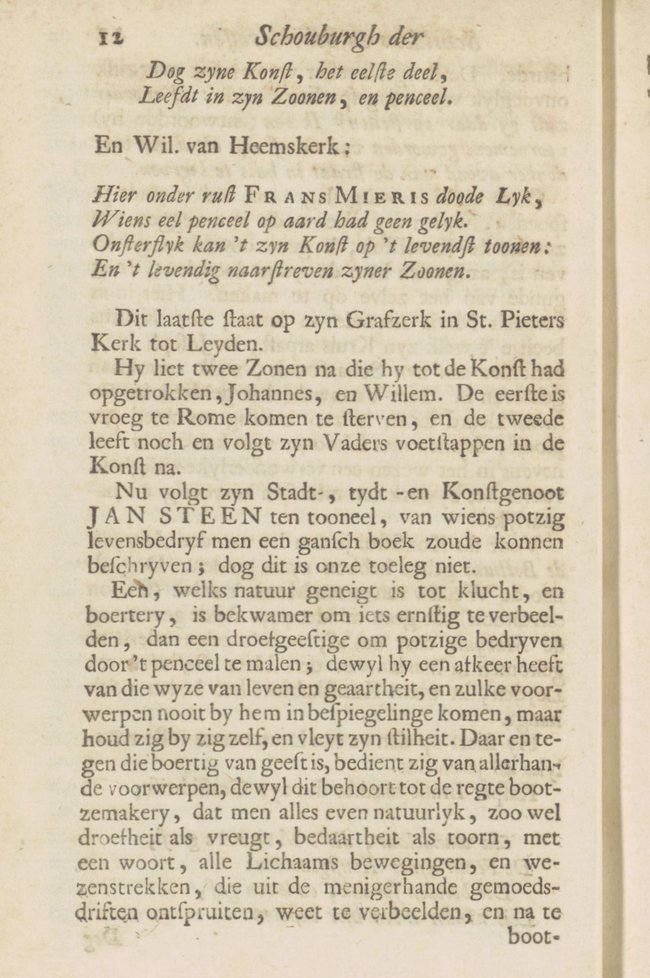
Page 13
The biography of JAN STEEN and the content of his artful brushwork will confirm my claims.
In general I must say that his paintings were like his way of life and his way of life like his paintings.
He was a student of Jan van Goyen, who loved him especially for his wit, and sometimes took him along in the evenings, when he had stopped painting, to have a beer and to chat a little with him. Jan likewise loved his master, but even more his daughter, whom he had treated so farcically that she began to swell ever more. Margariet (so she was called) prodded him repeatedly to make this known to his parents and her father; so that they could get married before it became common knowledge. He seized the opportunity as he was headed to the tavern with his master, to whom he said: I've heard some news that will really surprise you. And what is that asked van Goyen? What that is said Jan, Griet has to go into confinement. Do you know that for sure said van Goyen? Well yes, said Jan, would I not know it for sure, I did it myself and am also willing to marry her. This decided the matter, so that van Goyen, who knew that things done cannot be reversed, at least things of that nature, did not give Jan a hard time but charged him to make this known to his parents so that they might approve the marriage and that everything should proceed with order and honour. But Jan, who was a little afraid of his father, did not have much of an ear for this. However, Griet knew how to talk him around so sweetly that he did it. He then left for Delft, where his father was a brewer,
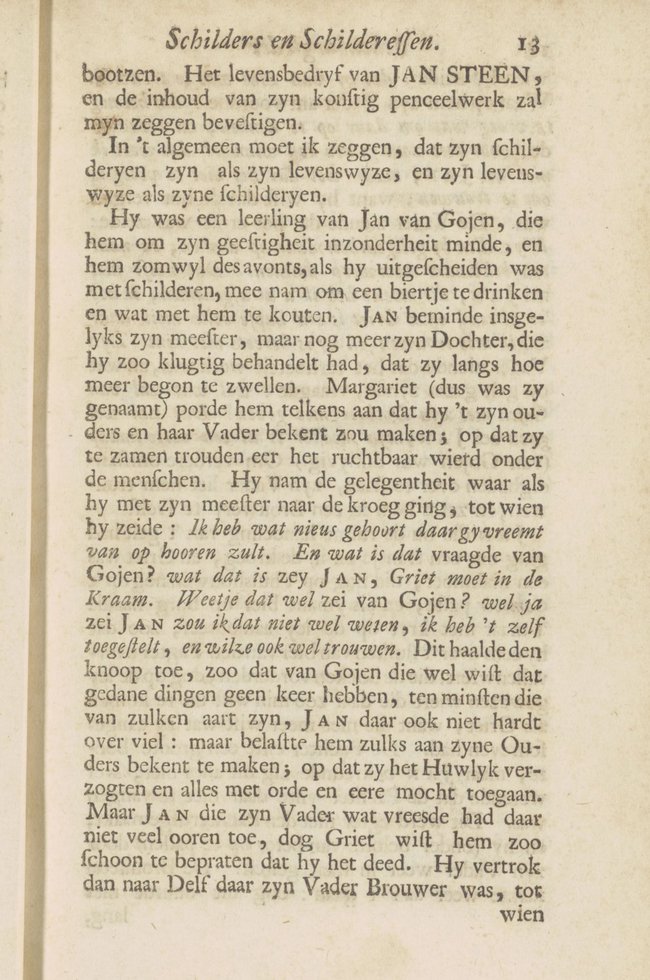
Page 14
to whom he said: that he was in the mood to marry. To which his father replied: that it was still too early to be thinking about that, and continued what would you do for a living? That I don’t know said Jan, but I do know that it is not too soon to marry; because he knew that the milk had been spilled. The father, seeing that he was serious, said: We shall think about it in due time, and look around for a suitable object. There is no need said Jan, I have already spared you the trouble, I already have one, our Griet is a plump and comely girl whom I will marry, and she is already with child. His father, seeing that it was a lost cause, and being a little too attached to money, asked: well what is van Goyen going to give along with his daughter? That should be all right said Jan. My master is already a man of substance (van Goyen was corpulent). To pass over other circumstances, his father let him marry and set him up in a brewery in Delft.
Jan, who now had ready access to money, went for a walk and to the pub, and Griet was a lazy mother who watched neither household nor accounts. And when someone got beer on account, she noted it in chalk on the slate, so that when she was once challenged about the consumption of beer by the landlord, who demanded to see the books, she pointed him to the slate, of which he could make no more sense than Griet, since she no longer knew what she had written down. The leaseholder demanded a large fine, but Jan was not concerned about any of this, knowing that the leaseholder was fishing were there was nothing to be caught. However, this was settled with the leaseholder and (with the promise to pay better attention) he was put back in business by his father. The brewing kettle went back on the go: but this did not last long,
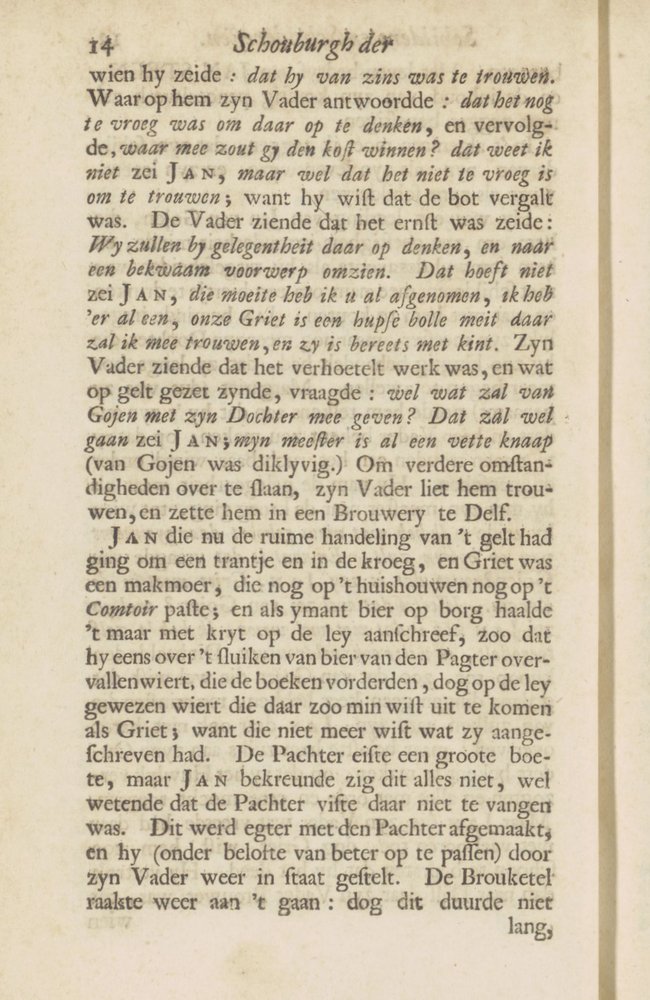
Page 15
for he went his old ways, and bought wine with his money instead of malt, so that on one occasion his beloved wife said to him: Jan, trade is dwindling, the clients are coming in vain, there is no beer in the cellars, not even enough malt to brew a batch, what's to be done? You are supposed to keep the brewery lively. I will keep things lively, said Jan. He went to the market (after having charged the helpers with pumping the large kettle full of water) bought a brace of living ducks, had the rest of the malt dumped in and let the birds swim in it. Not being used to this, they flew madly back and forth through the brewery, and made such a racket that it attracted his wife; whereupon he said: Is there enough life in the brewery now? Though she did not feel much like it, she still could not keep herself from laughing at his comical act.
Then he took refuge in the brush. The first thing that he made was an emblematic image of his corrupt household. The room lay in disarray beyond order, the dog slobbered from the pot, the cat walked off with the bacon, the children rolled about unrestrained on the floor, ma took it easy in a chair and looked on this activity, and for a joke he had painted himself in it, with a rummer in the hand, and a monkey on the mantelshelf who peeked at all of this with a long snout.
With the passing of time he became inn keeper, but when the barrels were empty, he took in the wreath and closed the store. In between he sometimes painted a piece (as he had practiced art in his youth) for the wine seller, who supplied a barrel for it.
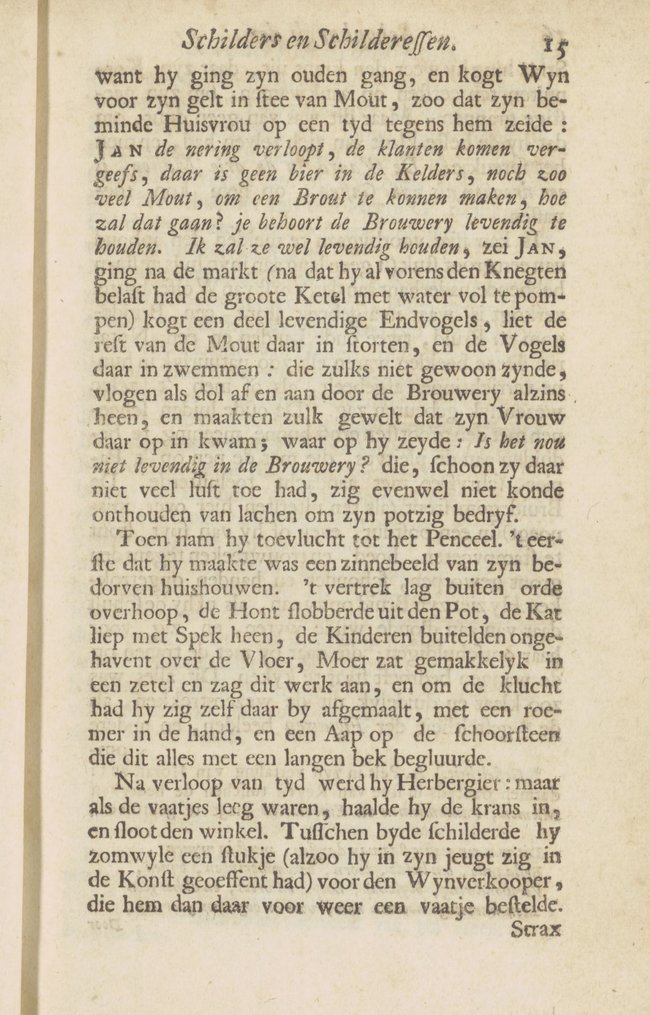
Page 16
At once the garland went back up, with his cronies the first to show up for his amusing jokes. But this was not of any duration, as he had his best client in himself, and one could apply the saying to him, the innkeeper of the three masts is drunk before his guests.
I cannot pass up mentioning the contents of a large piece (which stood in my house for a long time and which I later sold to the Pince of Wolfenbüttel [= Anton Ulrich von Braunschweig-Wolfenbüttel]), wherein were represented a bridegroom and a bride, two old folk and a notary [2]. All of these figures were painted so naturally in their actions that it was as if one actually saw this happening. The old folk seemed to express their opinion with great earnestness to the legal fox, who listened attentively with pen on paper, ready to write. The bridegroom stood (as if extremely displeased at this) in a posture much as if he were stamping his foot with distress, hat and marriage token cast to the ground, shoulders and hands raised. He looked sideways at his bride, as if he wanted to lay the blame for all this on the old folks and apologize to her, who stood there with tears on her cheeks, looking sad. All this was as clear and understandable from the expressions as well as from the postures* of the characters, and other circumstances
--------
* Postures. Andries Pels says in his translation of Horace: that in olden days instead of dancing in rows they were wont to use mimes, pantomimes and embolarien;
This was an amusing kind of dancing, mostly in mimes
Intended to express before the eye of everyone love, anger, cares, pain,
Amazement, hope and fear,
and all that people call passion
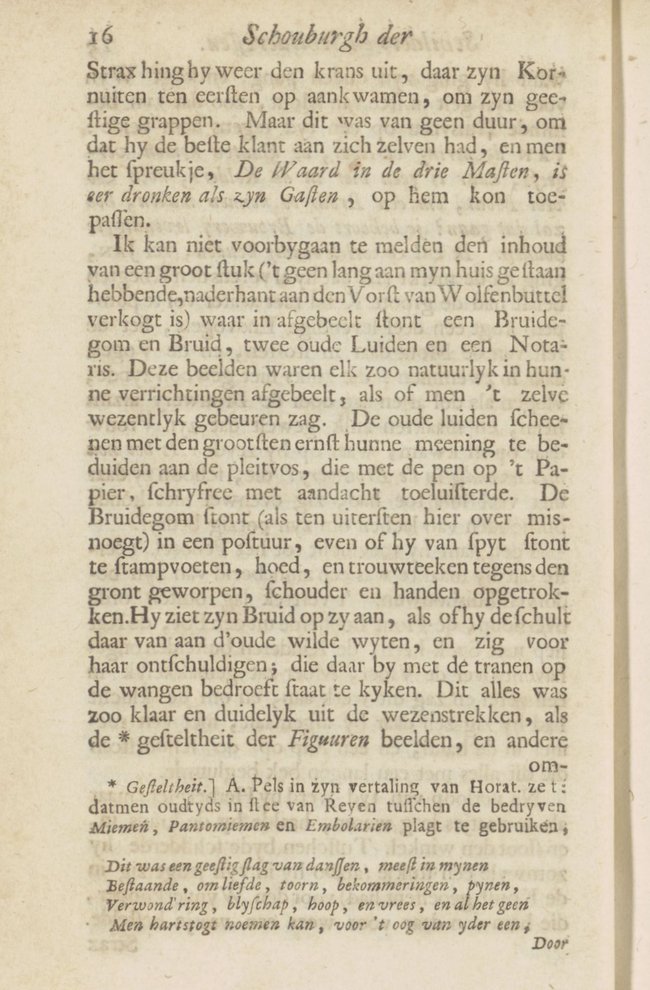

2
Jan Steen
The marriage of Tobias and Sarah: the signing of the Contract of Marriage(Tobit 7), c. 1667-1668
Braunschweig, Herzog Anton Ulrich-Museum, inv./cat.nr. 313
Page 17
as if it had been inscribed there. Just as naturally and inventively is painted by him is a lanky young wretch standing bawling because he sees (the piece shows a St. Nicholas evening, still to be seen in the art collection of Mister G. Franken in Dordrecht) a rod, or switch, stuck in his shoe, instead of something tasty.
Amongst his smaller kind of art pieces one finds many that have been elaborately painted after life and are no less inventive in thought. The art-loving Mister Lambert van Hairen, of Dordrecht, had one of these (for his honour is dead), which depicts a whore’s hovel, in which the whores have snared a strange cock-pigeon, who is being fleeced of his money through deception. One sees the earnestness in the man's face, and deliberation in the pulling of the card. Behind him stands an old, wrinkled procuress, who shows the card in a mirror to his opponent sitting opposite him, and who looks the image of villainy. Next to her sits a painted little whore who already basks in the certain profit that will follow at the end of the game. In addition the room and the furnishings are inventively arrayed, just as the carpet, which lies on the table, is painted in detail. But he did not get as much for it as people are now prepared to pay. Still he was always satisfied.
--------
Through bending of the body, grimaces and strange jumps
To express as if with the aid of human tongues.
This serves for the education of painting youths so that they get used to impressing a fixed idea of all the body’s movements which originate from the motions of the soul, by which they can have their images look as if speaking, after the example of Jan Steen.
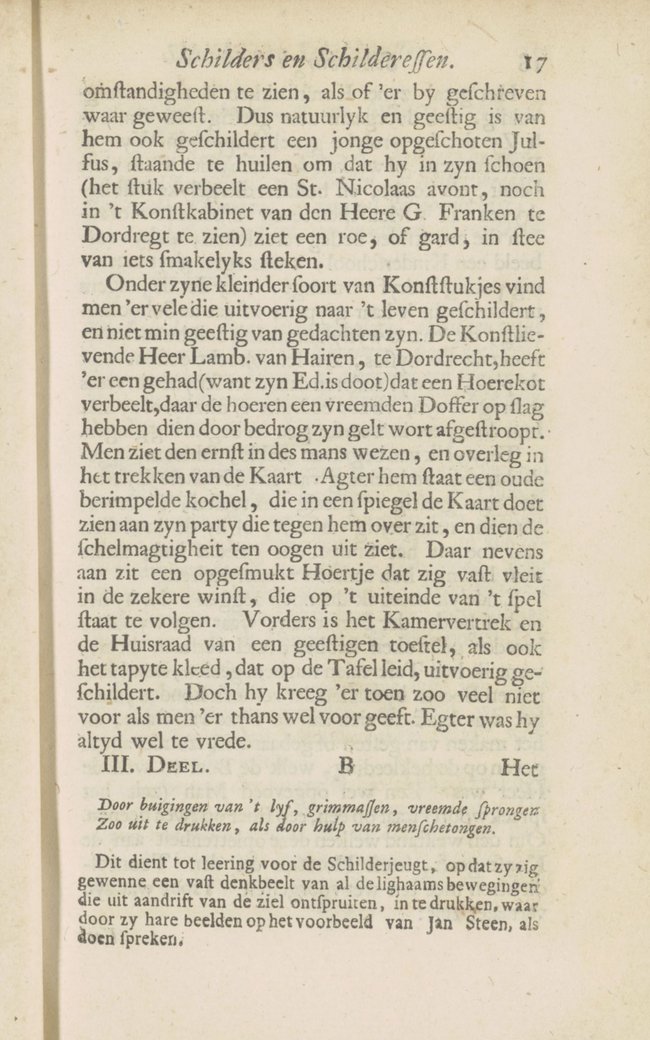
Page 18
The number of his art works is very plentiful and also generally very amusingly inventive. Be it that he depicted jolly companies in wine or beer pubs, or stores where more warm meat is fingered than bought and a hundred such loose acts of human life; or matters that require a quieter approach, such as, for instance, a children’s school. However, it was always mixed with comical acts, be it that the boys pull each other by the hair or that the school king, who looks as wise as ever did their predecessor Dionysius, carries out his school discipline with the strap while others, who appear to have been frightened by it all, look as dejected as if they were the first pair going to a funeral with their baptismal father.
While I mention funerals, it comes to my mind a depiction of a Quaker funeral procession, so inventively and comically equipped, and the features depicted so glumly as if he had borrowed the models for them from the insane asylum, so that one could not look at it without laughing.
Finally I still have this to say, that he thoroughly understood the distinctions between people, of which we have spoken more broadly elsewhere, because I have seen scenes by him in which gentlemen and farmers were depicted together, but it was almost to be seen from the way of standing and the making of movements or gestures, without paying heed to the clothing, who was a farmer and who a gentleman. A well-bred man (the saying goes) stands on one, a farmer on two legs. Because of the elegance that this observation brings to art, Horace also introduced it as one of his rules for playwrights. Hear what his translator [= Andries Pels] says:
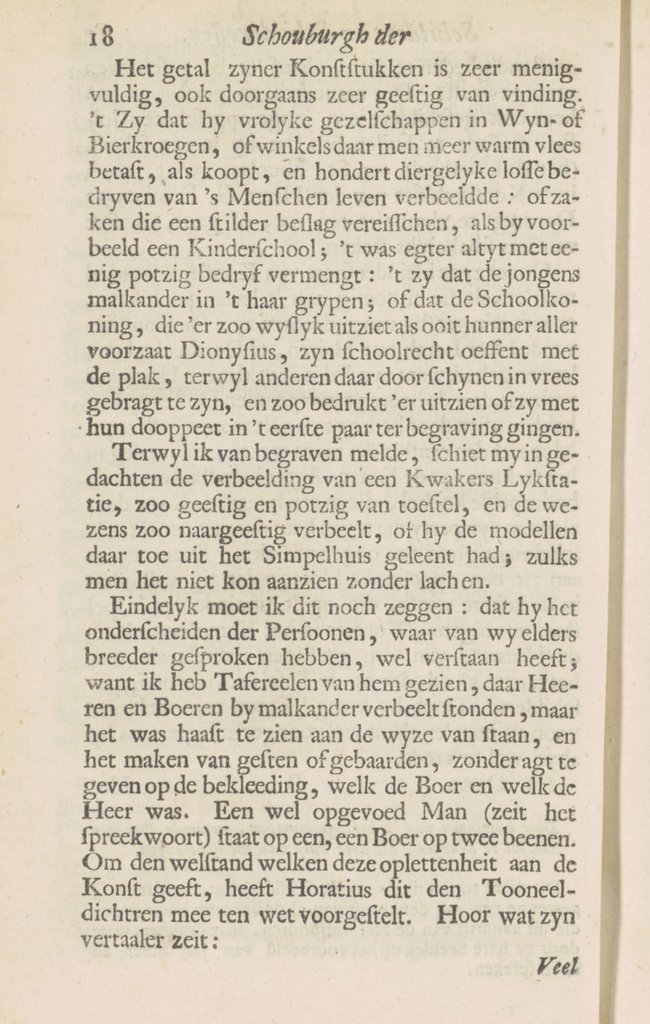
Page 19
It makes a big difference whether a master speaks, or a servant;
Or else a stately man, who knows of what he speaks,
Or playful youth, a queen, or nurse;
An incisive merchant, or simple shepherd;
A Spaniard, or a Pole; a Frenchman, or a Dane.
Or a little further on,
A farmer then, who brought from his plough or from a forest
You wish to bring on your stage, does not converse
Like an advocate's clerk, or some such talker;
Nor like a woman hawker from the Vygendam, or 't Water,
Your farmer will always remain a farmer ......
Those who are at all experienced in the training school of Pictura will readily understand what the poet means by this. To wit, that one should try to depict a person in his own natural capacity, in all his actions, in which respect I cannot point youthful painters for a concept of the same, to more competent examples than the brushwork of our Jan Steen.
The reader has already seen a commendable list of his art works unroll for which three digits per hundred is now paid more than when he lived.
It happened that he sold a piece of painting and had received some gold for it. His wife really wanted him to hand it over, but he sailed off to the tavern with it, drank up part of it and gambled away the rest, and
